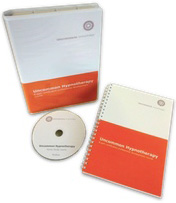
A large part of many psychological problems lie below the surface of consciousness
“I’m in two minds about that…”
“Part of me agrees with you, but…”
Have you ever used those expressions?
If you have, you’ll know what I mean when I say that a person’s identity isn’t singular.
When we talk about ‘me’ or ‘I’, which part are we really referring to?
The part that consciously makes decisions and intends to do something?
Or the part that dilates pupils, breathes during sleep, generates dreams, and activates the immune system?
All of us have a duality to our identity.
Prefer to watch instead?
The conscious mind and the unconscious mind, although clearly forming a total ‘whole’, appear to work as separate autonomous systems. Pupil dilation, dreaming, blushing, and other such unconscious processes feel as if they happen by themselves.
And yet, perhaps because we can exert conscious control over some of these processes (such as purposefully slowing down breathing), the conscious mind sometimes incorrectly takes responsibility for actions of the unconscious mind.
Ever heard someone rage…
“I’m so stupid for blushing!”
“Why can’t I just fall asleep?”
But of course no one consciously decides to blush or have insomnia – it’s the unconscious ‘part’ of them that’s doing it. And that’s the part we need to influence in therapy.
So, how can you use the conscious and unconscious mind to encourage positive change?
1) Be clear about which part of the mind actually directs behaviour
Of course, we still have to take responsibility for what we need to change in ourselves. But someone who likes to feel in control of things all the time may – by trying too hard to relax, fall asleep, or even be creative – find themselves trying to consciously control what is, in reality, an unconscious task.
This is not to say that what you decide to do consciously can’t influence these processes, but ultimately it’s your unconscious mind that runs the mechanisms by which these changes occur.
The more we can relax with the idea that it’s not the conscious mind directing a behaviour (blushing, smoking, healing, etc.), the more we can encourage the unconscious mind to take the reins and change the course of that process.
2) Split the conscious mind from the unconscious mind
If you’re a hypnotherapist, you can use a technique called ‘splitting’ to influence either the unconscious or conscious mind.
Firstly, when communicating hypnotically, be sure you know which part – conscious or unconscious – you are communicating with and seeking to influence. A good therapist will be absolutely clear in their own mind which part of the client’s mind they are directing their communication towards, and will modify how they communicate with this in mind.
For example, if I say to a client, “Okay, now make your blood pressure lower, please!”, I am speaking to them quite directly in a way that is really more appropriate to the conscious mind. But that is not the part that deals with autonomic processes like blood pressure.
So ‘splitting’ involves saying this to your client about lowering their blood pressure:
“Now, you know there are two parts to you. There is your conscious part, which is processing these words and is aware and may be analyzing what is going on, but there is a far larger part of you that is very able and can do things for you without you even needing to be aware that it’s happening…
“And it’s that part of you that I want to begin to appeal to right now – the part of you that is apart from the conscious part is so powerful and knows how to ease blood flow through your body…”
In this way, you purposefully and explicitly divide up the parts of the person. This is a way of implicitly saying, “Okay, your conscious mind can butt out of this because it’s your unconscious mind that is the expert here.”
3) Build up conscious curiosity
If the unconscious mind is going to do what it’s good at (lowering blood pressure, switching off the pain response, curing warts, or whatever), then it needs to be left alone by the conscious mind. We can ask the conscious mind just to sit back, be curious, and almost just watch what the unconscious mind does.
So you might continue the request for lowered blood pressure in this way:
“And as it does that… your conscious self may start to become very curious as to just how it’s going to feel once your blood pressure begins to lower a little… maybe you’ll notice your hands feeling a little warmer or just start to feel more relaxed generally…”
Again, this uses a specific type of language – what you might call the language of duality – to distinguish between the unconscious part that actually starts to produce changes and the conscious part that needs to stand back and just be curious about it as it notices it happening. This isn’t about trying to use hypnosis to ‘switch off’ the conscious mind, but rather giving it permission not to pay attention or to occupy itself with something else.
All good hypnotic inductions use the language of duality and you can even use it when asking yourself to produce hypnotic changes.
4) Using the language of duality for self-hypnosis
If I want to sleep deeply tonight (which, of course, I always do), I might encourage my unconscious mind to ‘do its thing’ by saying something to myself like:
“Now there is a part of me that just knows how to sleep deeply and nod off in just the right way… and right here and now I just want to make a little request to that part of myself for later… the part of me that knows all about those moments when I just gently start to slip into a beautiful deep and restful sleep…”
I also find that if I’ve forgotten something, such as someone’s name, it’s not much use trying too hard to consciously force the forgotten material back into my mind. In fact, that seems to make it even harder to remember! Instead, I might purposefully avoid trying to remember and just suggest to myself:
“Okay I need to recall this name and I’m going to stop thinking about it now… but I want my unconscious mind to search for me and when it has found that name, I want it to present it to me…”
This is a surprisingly effective way of getting your unconscious mind to do the work for you.
5) Trust the unconscious mind
Dr Milton Erickson would often ask his patients to ‘trust your unconscious’. By saying this, he was encouraging them to let the part of them that was expert at many things be allowed to work for them – without the conscious mind getting in the way!
I’ve only just touched the surface here of how to use the power of the unconscious mind to help yourself and others more effectively.











